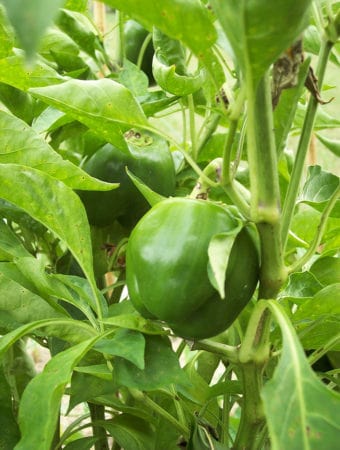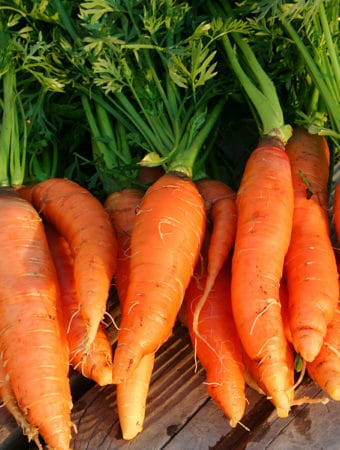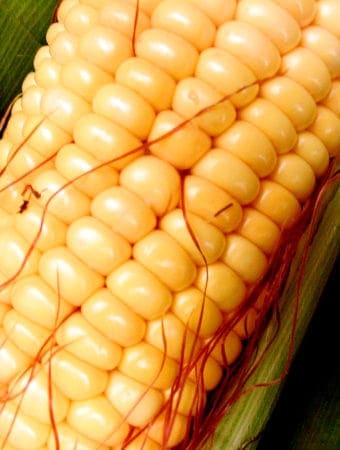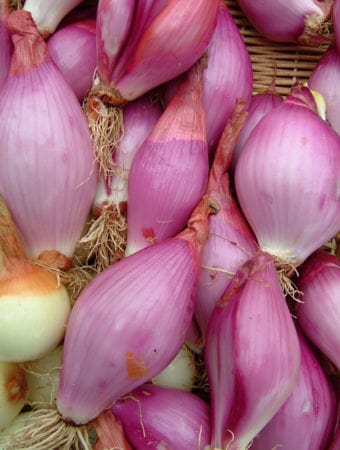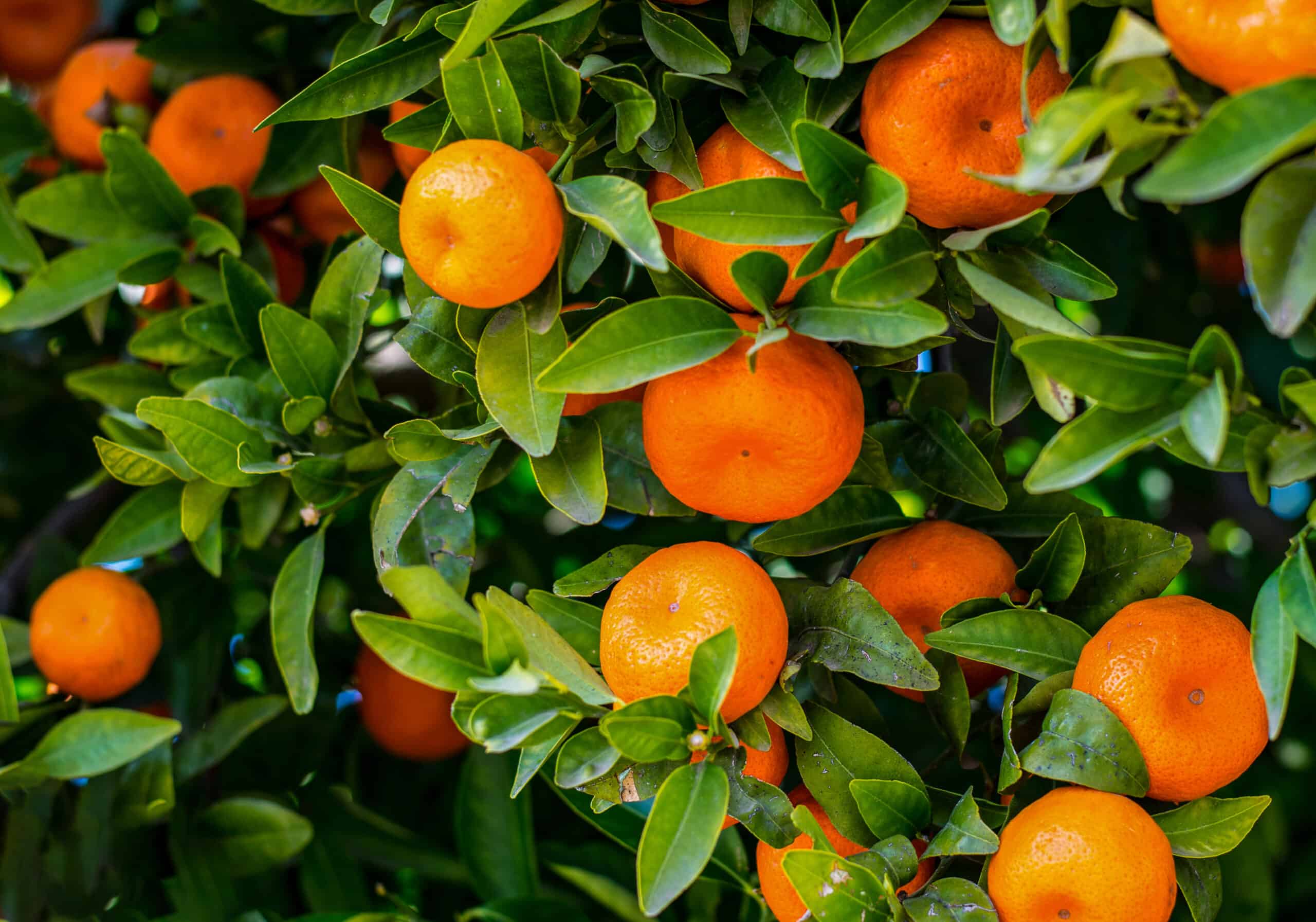 The mandarin orange (Citrus reticulata) is a small citrus tree that resembles an orange.
The mandarin orange (Citrus reticulata) is a small citrus tree that resembles an orange.
The mandarin orange is not one citrus fruit but many. Some mandarin oranges are called mandarins, some are called tangerines, and some are called clementines.
Most mandarins are half the size of an orange or smaller, but some are just as large. Most mandarins are oblate shaped tending to egg-shaped but some are round. Some mandarins have necks and others don’t. Some are orange, some are yellow-orange, and some are deep orange nearly red. Some mandarins are seedless and others are full of seeds. Some mandarins are very, very sweet and some are quite tart. Almost all mandarins are easy to peel; mandarins are sometimes called loose-skinned oranges or kid-glove oranges because they peel so readily.
A ripe mandarin will be firm to slightly soft and heavy for its size. Mandarins are easy to peel and to split into segments.
Mandarin trees can be tall and upright or weeping and willowlike depending on the variety. Mandarins vary in size and texture. Larger varieties such as ‘Dancy’ can grow to 20 feet tall and half again as wide. Smaller varieties including Clementines and Satsumas (there are multiple cultivars of each) are smaller and more compact growing to about 8 feet tall. Mandarins trees on dwarfing and semi-dwarfing rootstocks will be half the size.
Mandarins are tender and easily damaged by temperatures that drop into mid to high 20sF. Mandarins grow best in tropical and subtropical regions. Trees will likely be damaged if temperatures drop to 24°F if not protected. Fruit will be damaged at 28°F.
Mandarins are thought to have originated in south-eastern Asia and the Philippines but they have been widely grown in Japan, southern China, and India for hundreds of years.
The seediness of mandarins is unpredictable. ‘Pixie’ and Satsumas are almost always seedless. Others such as Clementine and ‘Nova’ produce seeds if a pollinizer variety is nearby. When mandarins are grown in locations where they are isolated from pollinizers the fruit is often seedless but fruit yield may be lower. There is no precise list of compatible pollinizers and the region where a variety is grown may play a role as to whether a variety is seedy or not. Trees are mostly self-fertile. Bees can increase pollination.
Many mandarins are alternate bearing; they produce a large crop of small fruit one year followed by a small crop of larger fruit the next season; hand thinning or pruning just after fruit set can help even out production.
 Mandarin Orange Growing Tips
Mandarin Orange Growing Tips
- Mandarins grow best in USDA Zones 9 and 10. Choose a location that gets at least 8 hours of sun or more each day. Plant trees in a protected spot away from a prevailing breeze or wind. Avoid planting in low spots where cold air or frost can settle.
- Plant mandarins in compost-rich, loamy soil that is well-drained. Keep the soil evenly moist. Protect plants with plant blankets if temperatures near freezing are forecast.
- Dwarf and semi-dwarf mandarins can be grown in containers. Choose a container at least 18 inches deep and wide for a young tree. Move trees to larger containers after a year or two.
- Mandarins can be grown indoors in a very brightly lit spot. Potting soil should be coarse, acidic and well-drained. Mandarins growing in containers in cold-winter regions should be moved indoors in autumn before the first frost.
- Mandarins are self-fertile. You can help a tree set fruit by taking a small brush and moving pollen from one flower to another. Bees and other pollinators can assist as well. Trees will begin bearing fruit at 1 to 2 years old. A mature tree will bear 40 to 50 fruits. Fruits commonly ripen from winter into spring.
- Mandarins, like other citrus, are usually not bothered by insect pests. Watch for slugs that will eat leaves and leafminers which will tunnel through leaves. Indoors watch for mites or aphids.
- Care must be taken when picking mandarin fruit or the rind will tear around the stem; clip stems with pruning shears is the best harvest practice.
- Plant a mix of trees with different times of maturity and harvest for a succession of fruit late autumn to early summer.
For more details on growing citrus see How to Grow Citrus.
 Mandarin Orange Varieties
Mandarin Orange Varieties
Here is a list of commonly grown mandarins; there are many more cultivars. Note, mandarin hybrids are listed separately below. You may also want to check articles on Tangelos and Tangors.
‘Changsha’: very sweet and juicy; resembles ‘Satsuma’; small to medium size puffy fruit; matures in autumn to early winter; seedy; very hardy; grown in cold areas of Gulf Coast; alternate bearing.
‘Clementine’ (also called ‘Algerian’): Clementine is a group of mandarin varieties, not a single variety; this is due to years and years of cross-breeding (Clementine cultivars include ‘Fina’, ‘Marisol’, ‘Arrufatina’, ‘Esbal’, ‘Oroval’, and ‘Clemenule’. Here are the characteristics of Clementine mandarins: sweet, juicy, aromatic flesh; medium-size fruit, a bit more than 2 inches tall and wide; red-orange rind; peels easily; few to many seeds; matures early (late fall into winter); fruit holds on tree several months past maturity; small to medium size tree with attractive weeping habit, dense foliage; needs pollinator for best fruit production but will be seedy after pollination; pollinators include ‘Dancy’ and ‘Kinnow’ mandarins, ‘Orlando’ tangelo, ‘Valencia’ orange; Clementine is adapted to all citrus regions; best suited to hot climates; best yield in desert.
‘Dancy’: rich, sprightly flavor, acidic; moderately juicy; fruit is about 2¼ inches wide and 1½ inches tall ; red-orange fruit, slight neck at the stem end; easily peels and separates into segments; few to many seeds; matures early winter; fruit does not hold well on tree; medium to large vigorous tree with few thorns; tendency to bear in alternate years; grow best in Florida but adapted to all citrus regions; can sunburn in desert regions.
‘Encore’: rich, sweet-tart flavor, juicy; medium-size fruit; orange skin with darker orange spots; rind peels easily; holds well on tree; late maturing—ripening later than other mandarins (spring into summer); medium-size tree with many upright, spreading branches and few or no thorns; tendency to bear heavy crops in alternate years; adapted to all citrus regions; not widely available. ‘Encore’ is the result of a cross between ‘King’ tangor and ‘Mediterranean’ mandarin.
‘Fremont’: very sweet, rich flavor; small to medium fruit; bight orange rind; easy to peel; seedy; matures late fall into winter; fruit stores well on the tree; tendency to bear heavily alternate years; a good choice for desert regions. ‘Fremont’ is a hybrid of ‘Clementine’ and ‘Ponkan’ mandarins.
‘Honey’: rich, very sweet flavor and juicy; small fruit; yellow-orange rind; peels easily; many seeds; matures midseason; fruit holds well on the tree; medium to large, spreading tree; tends to alternate bearing; adapted to all citrus regions. This mandarin is a cross between ‘Mediterranean’ and ‘King’ mandarins; this is a California variety. Florida-grown mandarins called ‘Honey’ are called ‘Murcott’ in other regions.
‘Kara’: sprightly flavorful, remains tart until very mature, juicy; medium-large fruit; deep orange rind; matures late, becomes puffy after ripening; very seedy one year, nearly seedless the next year; fruit holds fairly well on tree but becomes pithy the longer it hangs on tree; medium to large tree with drooping habit; thornless; adapted to interior California where it is the most flavorful; fruit is tart near coast; frost sensitive; tendency to bear heavily alternate years. This is a cross between ‘Owari’ satsuma mandarin and ‘King’ tangor.
‘Kinnow’: rich, aromatic flavor, juicy flesh; medium size fruit; yellow-orange rind; seedy; matures midseason; fruit holds well on the tree; a columnar tree with many long, slender, thornless branchlets; frost-tolerant; a tendency for alternate bearing; adapted to California and Arizona desert regions. ‘Kinnow’ is the result of a cross between ‘King’ tangor and ‘Mediterranean’ mandarin.
‘Mediterranean’ (‘Willow Leaf’): sweet, very juicy, distinctly aromatic flesh; medium size fruit; yellowish-orange rind; peels easily; matures winter to spring; fruit does not hold on tree, deteriorates quickly after maturity; moderately vigorous, broad, willow-like spreading tree; few to no thorns; high heat produces best fruit flavor but tree is very cold tolerant; tends to bear in alternate years; grown widely in California, Spain, and Italy. This was the first mandarin grown in the Mediterranean basin.
‘Owari’: Satsuma mandarin (see below); rich, subacid flavor; medium size fruit about 1½ inches tall and wide; orange rind, slightly rough and lumpy, peel can remain slightly green when ripe; orange flesh; 1 to 4 seeds; small, thornless tree; grown mainly in Florida, Alabama, and Gulf States.
‘Pixie’: pleasant and mild, sweet flavor flesh, moderately juicy; small to medium size fruit; bumpy, yellowish-orange rind; easy to peel; seedless; matures in spring; large, upright tree; tendency to bear in alternate years; grows well in California, best adapted to coastal and intermediate inland regions. ‘Pixie’ is the result of open pollination of ‘Kincy’ mandarin and ‘King’ tangor and ‘Dancy’ mandarin hybrid.
‘Ponkan’: also called ‘Chinese Honey’ mandarin; very sweet flavor, nice aroma; large fruit about 3 inches tall and wide with small neck; deep orange rind; loose skin, easy to peel; few seeds; ripens early winter; medium-size tree, upright habit; cold-hardy but less hardy than Satsumas; tendency to bear alternate years. ‘Ponkan’ has been grown in tropical climates around the world where it has been known as ‘Batangas’, ‘Mohali’, ‘Nangpur’, ‘Suntara’, and ‘Warnurco’. Strains of ‘Ponkan’ grown along the Gulf Coast include ‘Atlas Honey’ and ‘Pong Koa’.
Satsumas: Satsuma is not a single variety of mandarin but a group of mandarin varieties grown from the species Citrus unshiu. Satsumas have the following characteristics: mild, sweet flavor, low acid; medium size fruit; orange, loose rind; peels easily; seedless; matures early, begins to ripen in fall; fruit holds poorly on tree, becomes puffy and deteriorates quickly after maturity; stores well refrigerated; small to medium size, spreading tree which is slow-growing; very cold hardy. Satsumas grow well in Northern California, Texas, and Gulf Coast. Satsumas are early-ripening mandarins. The best known is ‘Owari’ Satsuma; other Satsumas are ‘Armstrong Early’, ‘Bower’, ‘Dobashi Beni’, ‘Frost’, ‘Kimbrough’, ‘Okitsu Wase’, and ‘Silverhill’ (‘Silverhill’ is a selection of ‘Owari’.
‘Wilking’: rich flavor, juicy; small to medium size fruit; deep orange rind; peels easily; seedy; small to medium size, moderately vigorous tree; few or no thorns; cold tolerant; tendency to bear alternate years; heavy fruiting can damage limbs. ‘Wilking’ is the result of a cross between ‘King’ tangor and ‘Mediterranean’ mandarin.
 Mandarin Hybrids
Mandarin Hybrids
‘Ambersweet’: orange-like flavor with hint of mandarin; medium size fruit; peels easily; few seeds if cross-pollinated; matures midseason; fruit holds well on tree; upright, moderately vigorous tree; good hardiness; cross of ‘Clementine’ mandarin, ‘Orlando’ tangelo, and mid-season orange; often marketed as an orange.
‘Calamondin’: believed to be a mandarin-kumquat hybrid; sweet, tangy, and juicy; looks like a very small, slightly flattened orange; slightly seedy; easy to peel; dense, upright tree; nearly thornless; very cold-tolerant; widely grown in Asia; used in marmalades and ades; there is a variegated cultivar with green and white foliage and green striped immature fruit.
‘Fairchild’: rich, sweet, and very juicy; medium size fruit; many seeds; ripens in winter; pollinator improves yields; fruit holds on trees; medium-size, rounded, tree; nearly thornless; best in low deserts of California and Arizona and also grown in South Texas; requires heat; cross of ‘Clementine’ mandarin and ‘Orlando’ tangelo hybrid.
‘Fallglo’: sprightly flavor, very juicy; large fruit; bright orange rind; easy to peel; seedy; matures early; vigorous, upright tree; few thorns; not hardy; limb dieback common on young trees; a ‘Temple’ tangor and ‘Bower’ satsuma mandarin hybrid.
‘Fortune’: rich, sprightly flavor; medium to large oblate fruit; thin orange-red rind is pebbled; orange flesh is juicy; can be seedy; easy to peel; highly productive tree; fruit holds well on tree; spreading tree; developed for desert regions; believed to be a cross between ‘Clementine’ mandarin and ‘Orlando’ tangelo.
‘Lee’: sweet, aromatic flavor, very juicy; medium size fruit; deep orange rind; easy to peel; seedy if grown without pollinizer; matures midseason; fruits hold well on tree; medium-size tree; few thorns; good hardiness; primarily grown in Florida; cross of ‘Clementine’ mandarin and a ‘Orlando’ tangelo.
‘Nova’: rich, aromatic flavor; juicy; medium to large fruit; deep orange-red rind; easy to peel; seedless if grown without cross-pollination; fruit holds well tree but can be grainy after maturity; medium-size tree; thorny; fruit may sunburn in desert regions; cross of ‘Clementine’ mandarin and a ‘Orlando’ tangelo.
‘Osceola’: small bright orange fruit; fall-bearing tree; needs a pollinator; cross of ‘Clementine’ and ‘Orlando’ tangelo hybrid; developed in Florida.
‘Page’: rich, sweet flavor, excellent for juice; small to medium fruit; orange-red rind with rind circle on blossom end; nearly seedless; matures mid-fall into winter; fruit holds well on tree; medium to large tree with round top; almost thornless; sometimes alternate bearing; pollinators include ‘Dancy’, ‘Orlando’ tangelo, or ‘Valencia’ orange; cross between ‘Minneola’ tangelo and ‘Clementine’ mandarin.
‘Rangpur’ commonly called Rangpur lime: hybrid of mandarin orange and citron; acidic juice can be substituted for lime juice; complex flavor; reddish-orange small to medium size, rounded fruit looks and peels like a mandarin; deep orange very juicy flesh; seedy; can be used for punches and mixed drinks; fruit hangs son tree all year; tree has a bushy spreading habit, few thorns; grows to 15 feet; everbearing in mild climates; termed a sour acid mandarin.
‘Robinson’: very sweet fruit; thin-skinned, deep orange fruit; can be seedy with a pollinator; fall-bearing; grows best in Florida and California, not desert; a cross of ‘Clementine’ and ‘Orlando’ tangelo hybrid.
‘Sunburst’: mild, sweet flavor; medium to large fruit; bright orange-red rind; thin-skinned, seedy; matures early; medium to large tree; somewhat hardy; tendency to alternate year bearing; cross between ‘Robinson’ and ‘Osceola’.
Also of interest:



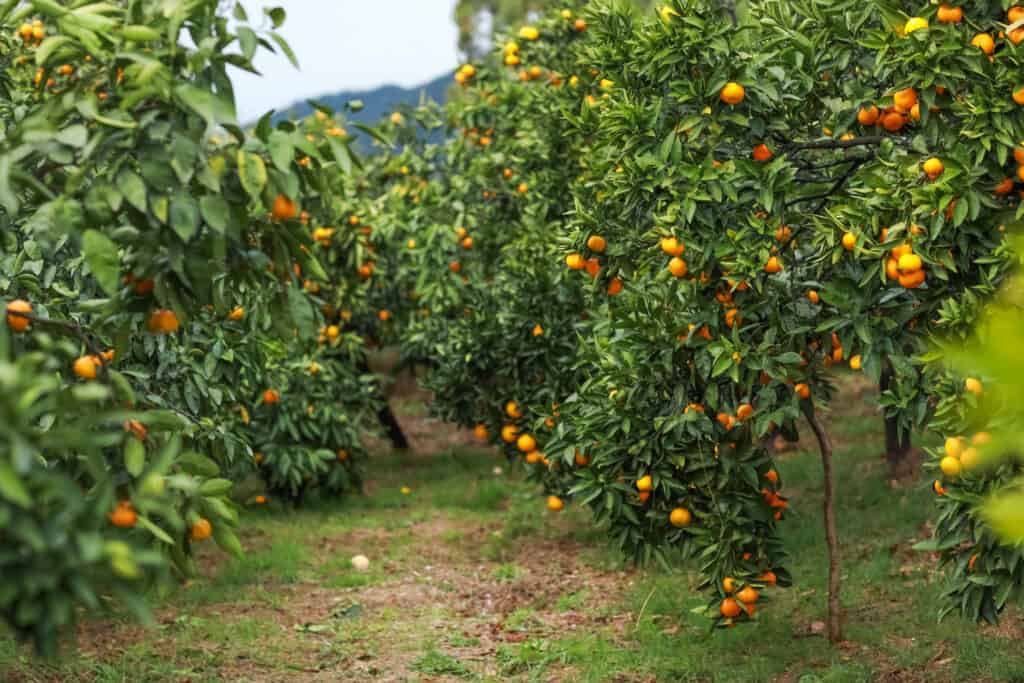 Mandarin Orange Growing Tips
Mandarin Orange Growing Tips Mandarin Orange Varieties
Mandarin Orange Varieties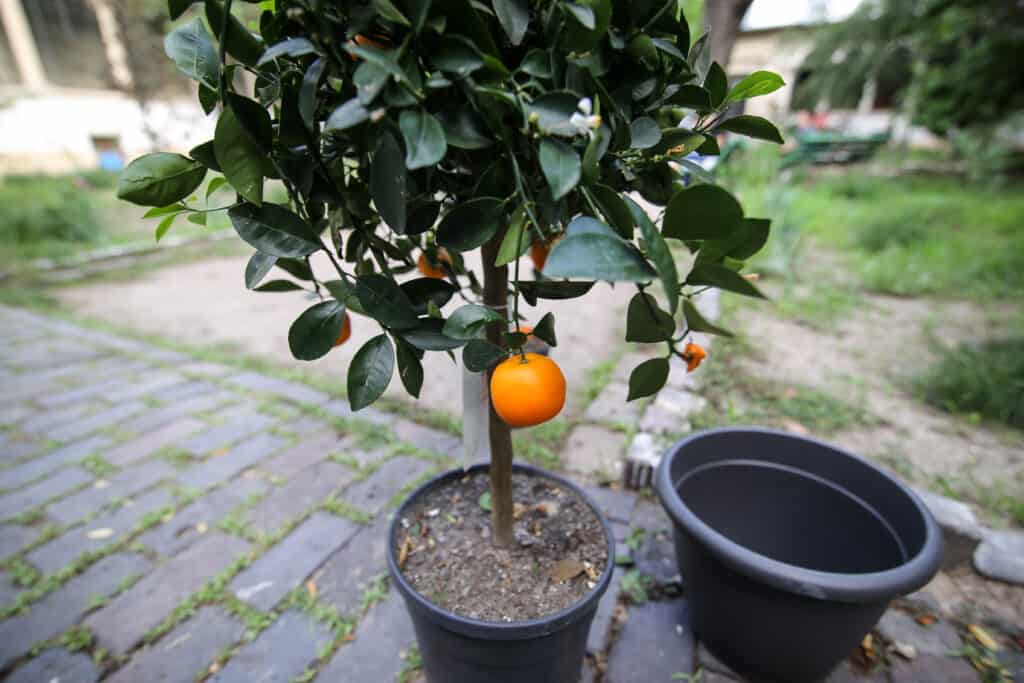 Mandarin Hybrids
Mandarin Hybrids
